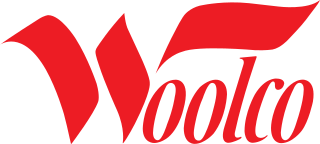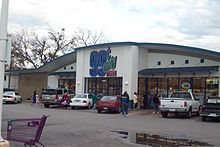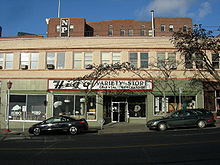
Frank Winfield Woolworth was an American entrepreneur, the founder of F. W. Woolworth Company, and the operator of variety stores known as "Five-and-Dimes" which featured a selection of low-priced merchandise. He pioneered the now-common practices of buying merchandise directly from manufacturers and fixing the selling prices on items, rather than haggling. He was also the first to use self-service display cases, so that customers could examine what they wanted to buy without the help of a sales clerk.

The F. W. Woolworth Company was a retail company and one of the pioneers of the five-and-dime store. It was among the most successful American and international five-and-dime businesses, setting trends and creating the modern retail model that stores follow worldwide today.

100-yen shops are common Japanese shops in the vein of American dollar stores. Stocking a variety of items from clothing to stationery, housewares to food, each item is priced at precisely 100 yen, which is considered attractive to Japanese consumers because it can be paid for with a single 100-yen coin. However, the current Japanese sales tax of 8% or 10% is also added, making a 100-yen purchase actually cost 108 or 110 yen. Larger items, like furniture and tools, may also cost more yet are still relatively affordable, usually costing less than 1000 yen.

Woolco was an American-based discount retail chain. It was founded in 1962 in Columbus, Ohio, by the F. W. Woolworth Company. It was a full-line discount department store unlike the five-and-dime Woolworth stores which operated at the time. At its peak, Woolco had hundreds of stores in the US, as well as in Canada and the United Kingdom. While the American stores were closed in 1983, the chain remained active in Canada until it was sold in 1994 to rival Walmart, which was looking to enter the Canadian market. All of the former UK Woolco stores were sold by Kingfisher, which had bought the UK Woolworth business, to Gateway which subsequently sold them to Asda.

HEMA, is a Dutch variety chain store. The chain is characterized by relatively low pricing of generic household goods, which are mostly made by and for the chain itself, often with an original design. The owner is Dutch billionaire Marcel Boekhoorn, who has lost control to bondholders.
A discount store or discounter offers a retail format in which products are sold at prices that are in principle lower than an actual or supposed "full retail price". Discounters rely on bulk purchasing and efficient distribution to keep down costs.

Dollar Tree, Inc. is an American multi-price-point chain of discount variety stores. Headquartered in Chesapeake, Virginia, it is a Fortune 500 company and operates 15,115 stores throughout the 48 contiguous U.S. states and Canada. Its stores are supported by a nationwide logistics network of 24 distribution centers. Additionally, the company operates stores under the name of Dollar Bills, as well as a multi-price-point variety chain under the Family Dollar banner.
Ben Franklin is a chain of five and dime and arts and crafts stores found primarily in small towns throughout the United States, currently owned by Promotions Unlimited of Mount Pleasant, Wisconsin. They are organized using a franchise system, with individual stores owned by independent proprietors. It was perhaps the first retail franchise, starting in 1927. They are named after Benjamin Franklin, taking a cue in their merchandise offerings from Franklin's saying, "A penny saved is a penny earned."

J. J. Newberry's was an American five and dime store chain in the 20th century. It was founded in Stroudsburg, Pennsylvania, United States, in 1911 by John Josiah Newberry (1877–1954). J. J. Newberry learned the variety store business by working in stores for 17 years between 1894 and 1911. There were seven stores in the chain by 1918.
TG&Y was a five and dime, or chain of variety stores and larger discount stores in the United States. At its peak, there were more than 900 stores in 29 states. Starting out during the Great Depression in rural areas and eventually moving into cities, TG&Y stores were firmly embedded in southern culture as modern-day general stores with a bit of everything. The chain used the advertising slogan, "Your best buy is at TG&Y." The founders articulated their business philosophy as "...have what people want at a price they can afford to pay,"
Service Merchandise was a retail chain of catalog showrooms carrying jewelry, toys, sporting goods and electronics. The company, which first began in 1934 as a five-and-dime store, was in existence for 68 years before ceasing operations in 2002.

Woolworths Supermarkets is an Australian chain of supermarkets and grocery stores owned by Woolworths Group. Founded in 1924, Woolworths today is Australia's biggest supermarket chain with a market share of 33% as of 2019.
Home Bargains is a British variety store chain founded in 1976 by Tom Morris in Liverpool, England, as Home and Bargain. It is the trading name of TJ Morris Ltd.

99p Stores Ltd. was a family-run business founded in January 2001 by entrepreneur Nadir Lalani, who opened the first store in the chain in Holloway, London, with a further three stores opening later that year. In 2002, Lalani decided to expand the business throughout the UK and had rapidly developed 99p Stores, operating a total of 129 stores as of March 2010 and serving around 1.5 million customers each week, undercutting their main rival Poundland by a penny. As of mid-2009 the company offered more than 3,500 different product lines throughout its stores.

Charles Sumner Woolworth, was an American entrepreneur who went by the nickname of "Sum", opened and managed the world's first five-and-dime store in Scranton, Pennsylvania, and was founder of the "C. S. Woolworth & Co" chain of 5¢ & 10¢ stores. Sum's brother, Frank Winfield Woolworth, was first to venture into the retail business with his own store, and soon after, he asked Sum to join him. Frank founded "F. W. Woolworth & Co", which later merged with other Woolworth affiliate stores to be the F. W. Woolworth Company. After the death of his brother, Sum became the longest serving Chairman of the F. W. Woolworth Company. During the early years, Sum also partnered with a long-time friend, Fred Kirby, to open a "Woolworth and Kirby" store in Wilkes-Barre, Pennsylvania. When Fred bought out Sum's share, that store grew to become a "friendly rival" affiliate store, in close alliance with the two Woolworth brothers.

E. P. Charlton & Company, also known as E. P. Charlton Company, E. P. Charlton, or simply Charlton's was an American chain of five and ten cent stores owned by Earle Perry Charlton, which merged with several associated brands to create the F. W. Woolworth Company in 1912.

MINISO is a Chinese low-cost retailer and variety store chain that specializes in household and consumer goods including cosmetics, stationery, toys, and kitchenware. Its headquarters are in Liwan District, Guangzhou under its Chinese holding company Aiyaya. In 2016, the company's sales revenue reached $1.5 billion. In March 2019, MINISO began a collaboration with Marvel Entertainment to sell its branded products.
The retail format influences the consumer's store choice and addresses the consumer's expectations. At its most basic level, a retail format is a simple marketplace, that is; a location where goods and services are exchanged. In some parts of the world, the retail sector is still dominated by small family-run stores, but large retail chains are increasingly dominating the sector, because they can exert considerable buying power and pass on the savings in the form of lower prices. Many of these large retail chains also produce their own private labels which compete alongside manufacturer brands. Considerable consolidation of retail stores has changed the retail landscape, transferring power away from wholesalers and into the hands of the large retail chains.



















